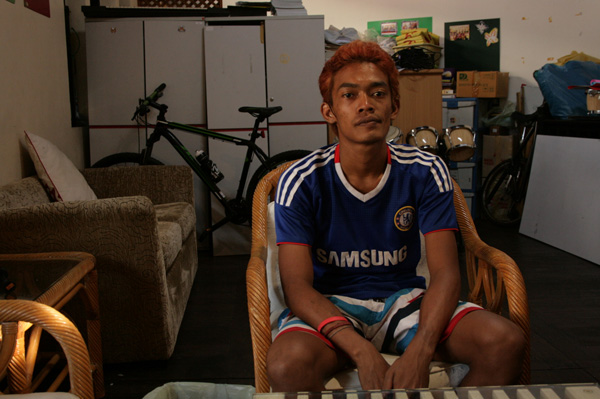 Somewhere amid the splendor and squalor of gilded shopping malls and destitute slums, Bangkok’s invisible children are exploited for labor, sex and criminal enterprise. Coconuts Bangkok wanted to find out more about who they are, where they come from and how they end up on the streets. After examining the commodification of their childhoods for begging, our second installment turns to the teens, many of whom inhabit a perilous world not by choice, but because it’s less traumatic than the homes they escaped.
Somewhere amid the splendor and squalor of gilded shopping malls and destitute slums, Bangkok’s invisible children are exploited for labor, sex and criminal enterprise. Coconuts Bangkok wanted to find out more about who they are, where they come from and how they end up on the streets. After examining the commodification of their childhoods for begging, our second installment turns to the teens, many of whom inhabit a perilous world not by choice, but because it’s less traumatic than the homes they escaped.
HIDDEN IN PLAIN SIGHT — Driven from home by domestic violence, hundreds of adolescents join the grim underworld of street-living each year.
While sleeping outdoors, running from police and scrambling for food during the day may not seem like a path anyone would willingly choose, it is often the lesser of two evils.
“A lot of people don’t understand. The kids are not masochists, they put themselves in this danger because their previous situation was even worse,” said Ilya Smirnoff, the Executive Director of the Childline Foundation, a nonprofit that runs The Hub, a youth center near the Hua Lamphong train station.
Whereas child beggars feed a massive industry and survival demands of some families, not all children lost amid Bangkok’s squalor and splendor are trading innocence for charity. Another population exists among homeless youth that are driven into the streets by even more dire circumstances – physical and sexual abuse at home.
Hidden in Plain Sight Part 1: Bangkok’s ‘invisible children’ exploited for profit
Domestic violence has been on the rise for the past decade, now affecting 30.8 percent, nearly one-third, of all households, according to a 2012 study by Mahidol University’s National Institute for Child and Family Development. Nearly half of all women report being physically or sexually abused by their partners. Sixty-one percent of families have a member suffering from alcohol abuse, which the children often say contributed to their parents’ violent tendencies.
“My father was addicted to alcohol and used to beat me when he was drunk,” said Nui, 19, a lanky adolescent with bleached hair.
“I ran away from my home in Nakhon Sawan, when I was 12,” he explained, adding that as a boy he lived in the Hua Lampong train station and survived on scraps from restaurants and food carts.
But as children grow older, handouts become more scarce. Life on the street only gets tougher, and adolescents break off into small gangs for security, especially at night. They are easy prey for drug dealers and street hustlers, who encourage them to escape their worries and sell their bodies. While government-run shelters abound through the country, many youths are reluctant to willingly incarcerate themselves after experiencing so much freedom, leaving them with few options beyond scrounging for survival.

Chronic survival mode
The Hub is a place where street youths can grab a shower, wash their clothes, sleep and – if they want – attend counselling and educational classes.
Given its location near the train station, it’s an area popular with transients, where cheap labour is always in demand and street walkers dominate the neighborhoods at night. The three-story building stands on a street where sex workers openly solicit for customers, and homeless teenagers huddle in groups at the corner of the block to numb their brains with deep huffs of glue.
The children have to leave their weapons – mostly pocket knives – at the door when they come in, according to The Hub’s rules. But staff don’t take them away out a pragmatic awareness that their lives on the street require strong survival skills.
“If the kids stop carrying weapons, stop being on the lookout, it is also dangerous for them because they will be desensitized to signs of danger,” Smirnoff said. “In street-living, it is always necessary for them to be aware and on the lookout.”
There is no end to the risks the children are exposed to on a daily basis, including “physical and sexual violence, exploitation, drug abuse and the danger of becoming in conflict with the juvenile justice system as they may violate the law [to] survive,” said Sirirath Chunnasart, a child protection officer with the UN Children’s Fund (UNICEF) in Thailand.
Last year Nui was stabbed while sleeping.
“I live in constant fear, especially at night, so I try to stay in safe areas,” he said. “I was unconscious and someone brought me to the hospital.”
He spent four days in the hospital until being released back into the street. He still doesn’t know the reason.
Other predators the youths have to fend off are pimps and drug dealers.
Nui’s sister, 16, also escaped their father’s drunken rage to join her brother in Bangkok, where she sells fruit drinks and sometimes her body to survive.
In March, 20 cases of pimps selling children for sex were brought to court, according to Childline, who alerted the police after three young girls ran into The Hub, away from an older woman who had been pimping them for months.
The woman was convicted and jailed, but the next week another pimp had already taken her place.
“It’s an endless cycle… These kids are subject to all kinds of atrocities,” Smirnoff said.
On the run with nowhere to go
Most of the youths are “social orphans,” meaning they have parents but come from dysfunctional, abusive, and often substance-addicted families, according to Childline.
“They have parents but no real kind of support,” Smirnoff explained.
They don’t want to return home to the abuse, and they are just as desperate to avoid official shelters.
While there are 29 government-run shelters in Bangkok housing around 7,000 children, the majority of street-living adolescents don’t want to go there as the institutions have strict rules commonly enforced with beatings, Chunnasart said.
“Staff at the institutions do not have skills to positively discipline children,” she said, explaining that corporal punishment is common, though lower since 2003’s Child Protection Act.
Still, physical violence doesn’t go over too well with children escaping its trauma at home.
Without any education, most can look forward to a future of menial work absent any skills.
The Hub offers standard, government-sponsored high school education classes and field trips for the children to see life off the streets in hope of inspiring some awareness of and drive toward alternatives.
But only about one-in-10 complete the courses.
“When you are in survival mode, your life is driven by fear,” Smirnoff explained.
And it’s impossible to separate the youths’ current problems from their past abuses, she added.
“You cannot see where the trauma ends and the street-living begins,” she said.
In April, police arrested Nui and a few of his friends for loitering in public while intoxicated. He spent 45 days in prison.
“Life doesn’t seem to give any breaks to these kids,” Smirnoff said.



